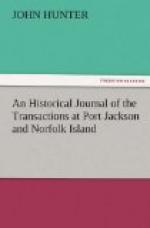After dinner I attended M. Peyrouse and his officers on shore, where I found him quite established; he had thrown round his tents a stockade, which was guarded by two small guns, and in which they were setting up two long boats, which he had in frame. After these boats were built, it was the intention of M. Peyrouse to go round New Ireland, and through the Moluccas, and to pass to the Island of France, by the streights of Sunda. An observatory tent was also fixed on shore, in which were an astronomical clock, a quadrant, and other instruments under the care of Monsieur D’Agelet, Astronomer, and a member of the Academy of Sciences at Paris: he, as well as Monsieur De la Peyrouse, informed me, that at every place they had touched at, and been near, they had found all the nautical and astronomical remarks of Captain Cook to be very exact and true; and he concluded with saying, “Enfin Monsieur Cook a tant fait, qu’il ne m’a rien laisse a faire, que d’admirer ses oeuvres.”
In the evening I returned on board the Boussole, and was shown all the drawings they had made during their voyage; and at five o’clock the next morning I set out on my return to Port Jackson, but did not arrive on board the Sirius before seven in the evening, having been obliged to row all the way against the wind and a great swell.
On the 4th, I went by land to Botany-Bay, accompanied by Lieutenant Ball, and some other officers: we found the country between that place and Port Jackson to consist chiefly of deep bays and sand hills, interspersed with a vast number of rocks: we did not return until the evening of the 5th.
About this time two criminal courts were assembled in order to try offenders, and as the proceedings in these cases are, in a great measure, new, a short account of them may not be unacceptable.
The judge-advocate issues his precept for the three senior naval officers and three military officers to assemble at the time appointed, dressed in their uniforms and their side-arms: when they are met, the judge-advocate administers an oath to the members, similar to that which is used at military courts-martial; afterwards, one of the members administers the same oath to the judge-advocate, who presides at the court, and the rest take their seats according to their rank. The prisoner is then asked, whether he is guilty or not, and, as the general answer is, “not guilty,” the accusations against him are read, and witnesses are examined on oath to support or prove the charge; after which the prisoner enters on his defence, and brings evidence to prove his innocence: the court is then cleared, and the members consider what sentence to pronounce; if it be death, five out of the seven must concur in opinion. The governor can respite a criminal condemned to die, and the legislature has fully empowered him to execute the sentence of the law, or to temper it with mercy.
Actions for debt, for a certain amount, are cognizable by this court, as are all other actions at common law, where they are decided according to the law of England, as nearly as the situation will allow.




